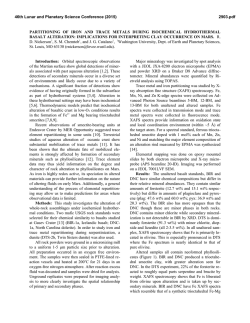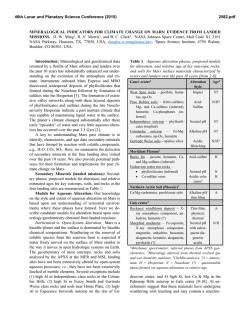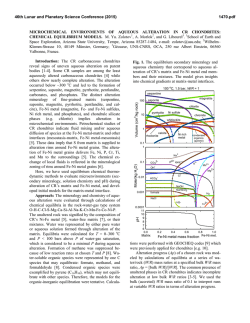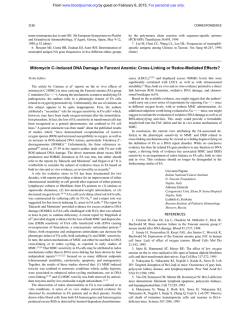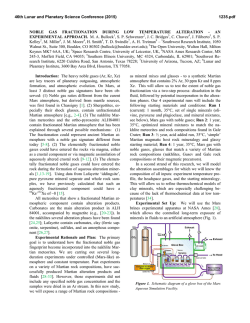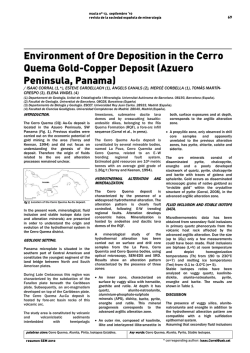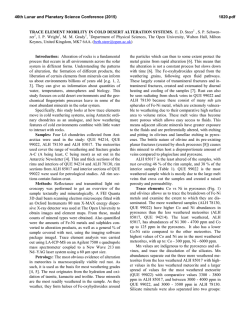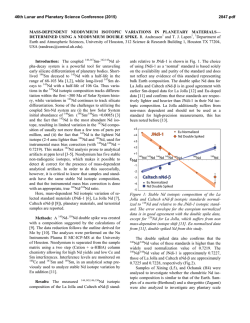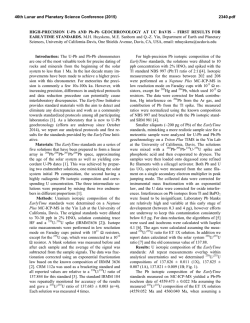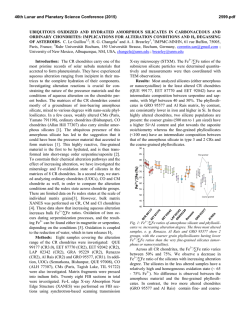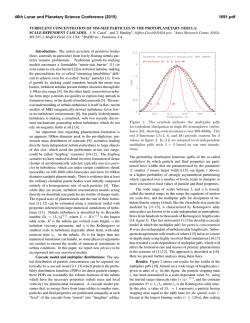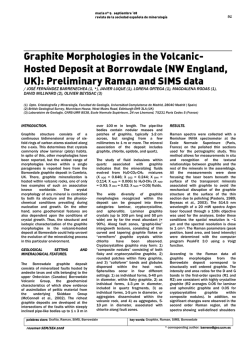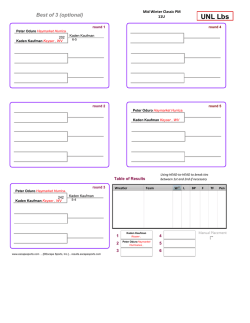
1515
46th Lunar and Planetary Science Conference (2015) 1515.pdf THE ORIGIN AND THE ALTERATION OF MACROMOLECULAR CARBON IN CR CARBONACEOUS CHONDRITES. P. J. Gasda, K. Nagashima, A. Thomen, G. J. Taylor, Hawai‘i Institute for Geophysics and Planetology, 1680 East West Road, Honolulu, Hawai‘i, USA 96822 ([email protected]). Introduction: The CR chondrites are important for studying the effects of aqueous alteration on the parent body because the CRs experienced a wide range of alteration and experienced very mild temperatures of alteration [e.g., 1]. To determine the origin [e.g., 2] and possible modification of macromolecular carbon (MMC) in the solar nebula [e.g., 3] and by aqueous alteration on the CR parent body [4], we performed an in situ study of the matrix, high carbon phases (HCPs) [5,6], and carbonates in Grosvenor Mountains (GRO) 95577 and Queen Alexandra Range (QUE) 99177 CR carbonaceous chondrites. GRO 95577 is a CR1, a completely altered meteorite, and QUE 99177 is a CR3, a nominally primitive meteorite that contains areas of intermediate aqueous alteration in dark inclusions [6]. Evidence from electron probe microanalysis of these two samples suggests that the MMC has experienced aqueous alteration on the CR parent body [5,6]. In this study, in situ C- and N-isotope analysis of the sample matrix, HCPs, and carbonates were performed to determine the mechanism of the alteration and the possible source of the MMC. Methods: Fusion crust free samples of Antarctic meteorites GRO 95577 and QUE 99177 were provided by the Johnson Space Center Meteorite Curation Laboratory as a chip with one polished side and as a chunk, respectively. Neither sample was impregnated with epoxy. GRO 95577 was not cut using oils or water, but was polished with diamonds and washed once with 95% ethanol. We mounted GRO 95577 in a 1” round indium metal slug (5N, Indium Corp.). Grains excavated from QUE 99177 were pressed onto Au foil (5N, EPSL, annealed). Both samples were simultaneously coated with 25 nm of Al (4N, Lesker) using a Torr International metal coater. The GRO 95577 sample was masked with Cu foil to ensure uniform ion extraction in the SIMS. The calcite standard (UWC-1) was mounted conventionally in epoxy, while the kerogen III standard (IFP 166286) was pressed into Au foil. Both standards were coated with Au. The in situ isotopic work was performed at the Univ. of Hawai‘i using the Cameca ims-1280 SIMS. A < 3 pA Cs+ primary beam was focused to ~1–2 µm and rastered over ~3x3 µm for each measurement. The secondary ions were measured in monocollection mode using the axial electron multiplier. Each measurement had a 300 s pre-sputtering time at 300 nA, 30 cycles per measurement, measuring masses (time in s): 12C− (2), 13C− (15), 12CH− (1), 18O− (1), 12C14N− (2), 12C15N− (30), 28Si− (1). A mass resolving power of ~7150 was used to separate the masses of 12C15N− and 12C14N− from interferences such as 11B16O−. A normal incident electron gun was used for charge compensation. Standards were measured daily before and after each block of measurements. Data were reduced using time interpolation and electron multiplier dead time correction. The carbon and nitrogen isotope compositions are reported in delta-notation in units of per mil (‰) relative to terrestrial carbon (Pee Dee Belemnite) or nitrogen (Earth atmosphere). Instrumental mass fractionation for C- and N-isotopes in organics is corrected using measurements of Kerogen III, an aromatic kerogen (H/C < 1) that is similar to the structure of the MMC in chondrites [7] and has a similar structure and H/C that we predicted earlier [6]. Calcite C-isotope measurement was corrected with the calcite standard. The reported 2σ uncertainty includes internal precision of individual measurement and reproducibility of standard measurements (see [6] for more details). Results and Discussion: We observe two clusters of N and C isotopic ratios in Fig 1, one for the HCPs and one for the matrix. The clusters are centered on δ13C ≈ –25‰ and δ15N ≈ 40‰ for the HCPs and δ13C ≈ –35‰ and δ15N ≈ 160‰ for the matrix. The two clusters are not tightly grouped and most individual N isotopic compositions are separated from each other, indicating some heterogeneity in both groups. Relative to the inferred δ15N and δ13C solar nebula values [8], the isotopic compositions of the HCPs and the matrix are 15 N-enriched and 13C-depleted. These compositions might be consistent with an origin in the presolar molecular cloud due to fractionation of N and C isotopes between the organics and CO and N gas [6,9]. A correlation between extent of alteration and organic isotope ratios in Fig 1 is not apparent. The HCPs in GRO 95577 have slightly elevated δ15N values, but this is likely due to physical mixing and sampling of the HCPs and the matrix as the HCPs are not compact and often contain matrix materials. The range in δ15N values in the GRO 95577 matrix is smaller than that in QUE matrix, and may indicate partial equilibration of nitrogen isotopes between the various organic compounds (such as the HCPs and the soluble organic carbon). Alternatively, the decrease in δ15N could be the signature of MMC alteration in the solar nebula if the MMC gained labile 15N organic groups after reacting with solar nebula products, as suggested by [3], and then lost these groups during aqueous alteration [6]. 46th Lunar and Planetary Science Conference (2015) The 15N-rich composition should be lost quickly during aqueous alteration because the 15N atoms are present mostly in the labile organic groups. Our results do not agree with those of other studies [9,10]. Specifically, [9] shows that water-soluble organic extracts of the matrix generally have a higher δ13C and a slightly lower δ15N compared to our data. [10] show that the δ13C composition of the acidinsoluble organic carbon has a δ13C and δ15N composition that is slightly less than the composition that we find in our samples. Our matrix measurements should be a mixture between endmembers composed of MMC and the soluble organic materials. Since there is no mixing line between the soluble phases from [9] and the acid-insoluble organics from [10] that would result in a mixed phase with the isotopic composition of the matrix cluster in Fig 1, we conclude that the acidinsoluble composition is not the correct endmember for the MMC. Instead, we hypothesize that a ‘missing’ endmember that is 13C-depleted and 15N-enriched organics corresponds to the MMC. A missing phase that is 15N-rich and 13C-poor compared to our samples would account for the isotopic values of the matrix cluster in Fig 1. Carbon isotopic measurements of the calcites appear to show a correlation with aqueous alteration in Fig 2. As aqueous alteration progresses, δ13C increases. The δ13C in QUE 99177 calcites range (including 2σ error) from approx. –30 to +20‰ and in GRO 95577 range from approx. –20 to +100‰. These compositions are distinct from those in HCPs and matrices. The combination of large variations in C isotope compositions, loss of organics in the matrix, the increase in H/C in the MMC, and the production of calcites in the GRO 95577 sample [see 6], leads us to hypothesize that the CO2 gas evolves, at least in part, from oxidation of the organics. Organic oxidants (e.g., peroxides) must have fully oxidized carbon in the matrix before producing CO2 to account for the loss of C abundance in the matrix. Equilibrium fractionation of carbon due to production of calcites only accounts for a ~6 to 10‰ (25 and 50°C) [11,12] difference in δ13C. Therefore, additional fractionation in an open system is required. Conclusions: The initial fractionation of the C and N in the presolar molecular cloud can account for all of the differences between the organics and the solar nebula C and N isotopic ratios [9]. MMC derived from these organics have a low H/C ratio, are depleted in 13 C, and enriched in 15N. A small fraction of the MMC may have interacted with photodissociation-related solar nebula products [3]. When the disk forms, there is a few 1000 ‰ fractionation of the N isotopes due to photodissociation of N2 in the optically thin surfaces of 1515.pdf the disk [3]. The heavy N needs to quickly react to form 15N-enriched organics and become stored in ices. If these solar nebula products are combined with the MMC, which has a very high in C# [6] and an N/C ratio of ~0.03 [10], the reaction introduces only a slight change to δ13C, but greatly increases δ15N of the MMC. Thus, reactions of the MMC with solar nebula products must not be efficient, if they happened at all. Acknowledgements: NAI CAN NNA04CC08A; French Institute of Petroleum; S. Sharma; A. Misra; A Krot References: [1] Weisberg, M. K. (1993) GCA, 57, 1567–1586. [2] Kerridge, J. F. (1999), Space Sci. Rev., 90, 275–288. [3] Chakraborty, S. et al. (2014) PNAS, 111, 14704–14709. [4] Brearley, A. J. (2006), Univ. of Arizona Press, Tucson, 584–624. [5] Gasda, P. J. et al., (2014) 45th LPSC abstract# 1558. [6] Gasda, P. J. (2014) [PhD Dissertation] University of Hawaii, Manoa. [7] Aléon, J. et al. (2003) GCA, 67, 3773– 3783. [8] Meibom, A. et al. (2007) ApJ, 656, L33-L36. [9] Elsila, J. E. et al. (2012) MAPS, 47, 1517–1536. [10] Alexander, C. M. O. ‘D. et al. (2007) GCA, 71, 4380–4403[11] Emrich, K. (1970) EPSL, 8, 363–371. [12] Romanek, C. S. (1992) GCA, 56, 419–430. Figure 1: Organics δ13C and δ15N with 2σ error. Figure 2: Organics & calcite δ13C with 2σ error.
© Copyright 2026

